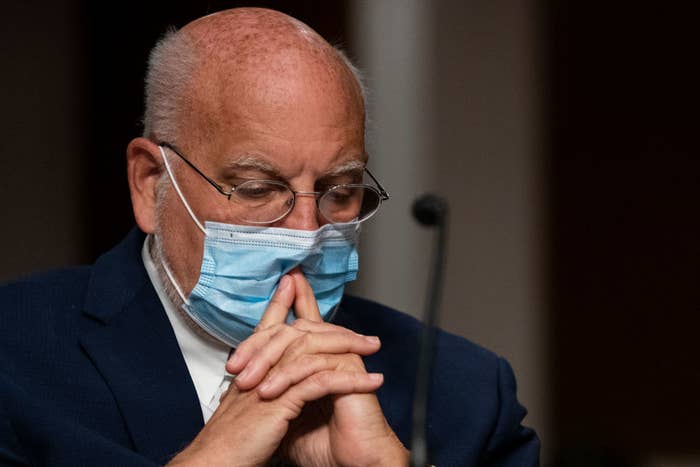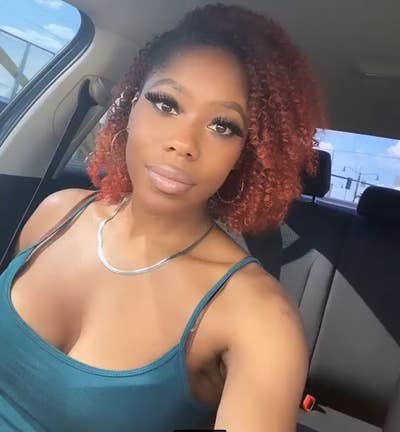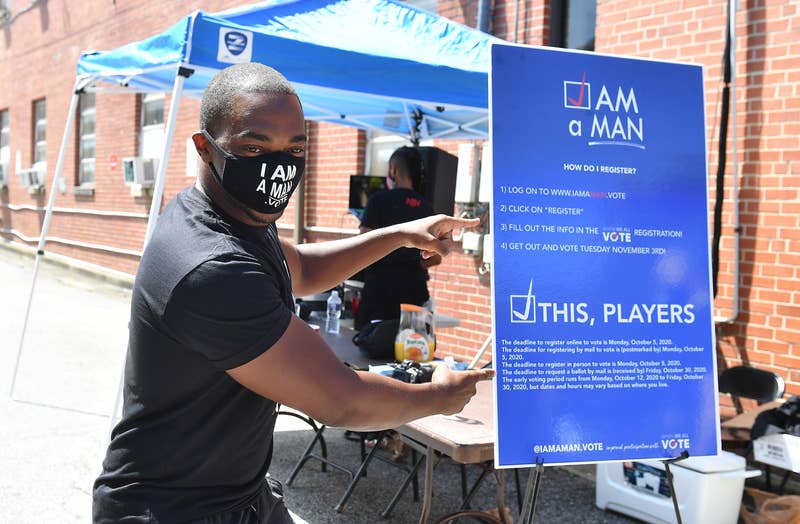Rally Around the Flag? The Far-Right Response to Covid-19
Europe’s far-right parties such as Alternative für Deutschland, the Lega and the Swedish Democrats have all struggled to find a message amid the pandemic. However, things might be changing. As populations tire of lockdowns and fear for their livelihoods, these parties are attempting to harness discontent and speak for “the people”. While some hope that scientific truths will win out against populist lies, the prominent place given to experts could produce a backlash. Ultimately the social and economic consequences of government measures will be decisive for the future of far-right populism.
The coronavirus pandemic has brought huge changes to all corners of the world. Daily life has been fundamentally transformed; working conditions, social events and international travel have all been disrupted. Besides the profound economic and social transformations in the wake of a global health crisis, how has the political landscape been affected? How have political parties fared? What has been the response of the far-right populist parties, who might have been expected to appreciate the closed borders? Six months ago, these parties were poised to make sweeping electoral gains. Before the pandemic, a populist surge was regarded by some as almost inevitable due to deep structural changes across Europe and the lack of political alternatives. An important question today is whether the coronavirus pandemic has dampened this surge or whether, on the contrary, it will provide it with new fuel.
Though there is good reason to be wary of sweeping generalisations and simplistic assumptions often made about populism in general, and right-wing populism in particular, it is worth comparing these parties in order to understand the variations and commonalities of far-right populism. Broadly speaking, populism works by championing “the people”, who are distinguished in populist discourse from “elites” or the “establishment”.[1] While left-wing populism makes the people an inclusive category, the populism of the far right constructs them in exclusive and ethnic terms, and distinguishes them from an unresponsive elite as well as from immigrants.[2]
Perhaps unsurprisingly in a war-like situation, we have witnessed what is referred to as a “rally around the flag” effect: many leaders and parties of governments have seen an increase in their approval ratings.
This division has apparently been difficult to maintain over recent months. Perhaps unsurprisingly in a war-like situation, we have witnessed what is referred to as a “rally around the flag” effect: many leaders and parties of governments have seen an increase in their approval ratings. This has made it difficult for far-right populist opposition parties to find and assert a strong message. And indeed, as Cas Mudde points out, “Populist parties and politicians have responded very differently, in part depending upon whether they are in government or opposition. They are also faced with very different contexts, both in terms of number of infections and control of the media.” Things might be changing. As populations tire of lockdowns and fear for their livelihoods, these parties are attempting to harness discontent and speak for the people against what is construed as hostile government policy.
This certainly seems to be the case with three far-right parties: the Italian Lega, the Alternative für Deutschland (AfD) in Germany, and the Swedish Democrats (SD). These parties have had striking electoral successes over recent years. They have acted very differently in response to the coronavirus-induced crisis but they all seem to struggle to carve out an appealing message and a strong identity during the pandemic. Currently, these parties are all continuing to construct national government policy as illegitimate and damaging. What is most pertinently revealed in our comparison is that this indictment is made regardless of government response to the crisis. Whether the strategy is to enforce a lock-down or resist it, populist parties construct a division between the people and the “other” by exploiting the coronavirus crisis.
Whether the strategy is to enforce a lock-down or resist it, populist parties construct a division between the people and the “other” by exploiting the coronavirus crisis.
Wavering message, wavering support
The Italian Lega, led by Matteo Salvini, is certainly not letting up on its populist framing of the crisis. With slogans such as “let’s close our borders”, the Lega is notorious for connecting immigration to insecurity as well as promoting the fining and expulsion of migrants. The Lega connected the Covid-19 virus directly to immigration from the outset. According to Salvini, the “terrible virus” was “spreading from China”. Note that in his discourse, the specific characteristics of the migrant might have changed (they no longer come from Africa but from Asia), but the construction and blaming of a foreign other has not.
During the first months of the lockdown, this anti-immigration discourse seemed to be completely out of touch with reality. First of all, due to the lockdown, NGO rescue boats had effectively ceased to operate, resulting in a sharp decline of people reaching Italy. Secondly, concerns over fresh food shortages, created by the disruption of the influx of legal seasonal workers, has sparked an acknowledgement of the importance of illegal immigrants for Italy’s agricultural sector.
Up until now at least, Salvini’s messages have largely fallen flat. Part of the reason may be that the lively rallies, where the Lega thrives most, are now banned under social distancing rules. Another may be that he has promoted inconsistent messages and flip-flopped. In February, Salvini argued that the Italian Prime Minister Giuseppe Conte was not doing enough but by July, he began touting that the prime minister was doing too much. Now Salvini is pronouncing the lockdown as unnecessary and harmful to the Italian people: “keeping them terrified, distanced and locked up is an attack on our democracy and our economy.” Although the Lega remains Italy’s strongest party, with 26 per cent share of the national voting intention, it has slipped in the polls. Yet it is important to acknowledge this slip as not indicating a weakening of the far right in Italy, but rather shifts of popularity within the country. The Lega has lost 10 per cent to the post-fascist party Fratelli d’Italia (FdI), turning its leader and Salvini’s most important ally, Giorgia Meloni, into a potential rival.
Germany’s struggling far right
The challenge for the far right in Germany has not been to maintain a consistent message but rather to find one in the first place. Like the Lega, the AfD is overtly populist. Consider its 2017 manifesto in which the party publicised its wish to: “maintain our language and traditions in a peaceful, democratic, and sovereign nation state for the German people” since “Germany’s political class has exploited and modified election laws and procedures with increasing cunningness in order to reduce the influence of the electorate.” It also targets migrants, in particular Muslims (established Muslim communities are targeted too), unambiguously declaring that “Islam does not belong to Germany. Its expansion and the ever-increasing number of Muslims in the country are viewed by the AfD as a danger to our state, our society, and our values.”
[…] while the stringent travel restrictions and strict border controls fit within the far-right discourse, the enactment of such policies has deprived the AfD of a distinctive position.
The problem for the AfD since the pandemic, however, has been that the German Chancellor, Angela Merkel, has been widely credited with effectively managing the crisis. Her party, the Christian Democrats, has seen the most noticeable increase in support in Europe. And this simply does not fit with the AfD’s populist insinuation that elected elites do not serve the German people. So while the stringent travel restrictions and strict border controls fit within the far-right discourse, the enactment of such policies has deprived the AfD of a distinctive position.
In general, the leadership of the party has been quite subdued throughout 2020, and the party has slipped to 10 per cent of the national voting intention. The pandemic came at a time when the party was already dealing with internal division and party infighting. The party has a radical far-right wing (known as “the wing”) which was formally dissolved in late March 2020, after the German domestic intelligence agency deemed it a potential threat to the constitution and put it under surveillance. In addition, prominent figures in the party have been pushed out due to their former membership in a banned neo-Nazi group.
But the formal dissolution of the wing has clearly done nothing to stop some of its members from questioning the reality of the global health crisis: various prominent party figures and former wing members have publicly referred to the “alleged corona crisis” while one posted a “checklist” to distinguish a pandemic from a “fake pandemic”. Prominent wing activists have also been active in the so-called “Hygiene Demonstrations” which have drawn thousands of people in cities across Germany to protest the government’s coronavirus policy. Protestors blame Jews and immigrant communities for the spread of Covid-19 in Germany.
These responses have begun to dominate the public impression of the AfD’s current position, and party leaders are concerned that the connection of members to neo-fascist groups, conspiracy theorists and anti-vaccination activists will alienate more moderate conservative voters. The coronavirus has therefore exposed the cleavage between the national-conservative party mainstream and the marginalised far-right wing – a divide that may, according to former party leader Alexander Gauland, actually end with the dissolution of the party.
The coronavirus has […] exposed the cleavage between the national-conservative party mainstream and the marginalised far-right wing – a divide that may, according to former party leader Alexander Gauland, actually end with the dissolution of the party.
Swedish exceptionalism, one step too far for populists
In contrast to both Italy and Germany, countries that have been experiencing strict lockdown policies, Sweden has kept its schools, restaurants and borders open. Its exceptional approach to the pandemic has been defended as entirely in line with science. The Swedish Minister for Health and Social Affairs Lena Hallengren stated: “All countries do the best they can, but so far there is no one who knows exactly how to best deal with this virus”. Swedish health experts have been given priority over advice from the World Health Organization (WHO), especially since their strategy is considered more in line with cultural particularities of the Scandinavian country.
This has left the far-right SD in a difficult position. Over the last decade, they have sharply increased their share of the vote to 20 per cent. Their unambiguously populist and ethnic-majoritarian discourse constructs an ethnically homogenous Swedes as antagonised by immigrant-friendly and politically correct elites. In order to oppose the Swedish government, the SD not only decries the relatively high mortality rate resulting from Sweden’s solo run a “massacre”, but they also urge the government to fall in line with the “international consensus”. This is an odd situation: the Swedish government’s strategy on the coronavirus crisis is based on highlighting the country’s exceptionalism and, of all parties, the SD is advocating the adoption of international blueprints.
No time for a victory lap
What can be concluded from the comparison of the three parties? Despite operating in different political landscapes and coping with their own issues, these parties have, nevertheless, continued to maintain a populist division between the people and the other (discursively constructed as immigrants and elites). Until recently, this has not resonated with publics. Commentators have observed that, so far, the far right might well be floundering in opposition while those in power are also struggling. However, this may well not be the case for much longer. Far-right populist parties are using the crisis to continue to divide the people from others: immigrants, foreigners, and social and political elites. As Yannis Stavrakakis and Giorgos Katsambekis note in an important recent report, crises are often seen as particularly opportune moments for the exaggeration of social and political divisions. The unevenly distributed effects not only of the virus itself, but of the strategies to tackle it, create an environment ripe for far-right populism.
The unevenly distributed effects not only of the virus itself, but of the strategies to tackle it, create an environment ripe for far-right populism.
Whether populist messages strike a chord with voters in the near future may well hinge on the way the forthcoming economic turbulence and uncertainty is handled. The potential of far-right parties to speak to popular discontent will depend upon the extent to which government responses to the crisis are seen to be legitimate, representative and democratic. This applies not only to the national and regional but also the European level. The general lack of coordination between EU institutions and the bitter negotiations between the member states on post-pandemic relief efforts may have opened the opportunity to reinforce the far-right populist divisions between national peoples and European elites. FdI leader Meloni, for example, directly accused the European Commission president of bias: “When the coronavirus was just an Italian problem it didn’t interest anyone in the European Union. When we had the first red zones in Lombardy, Ursula von der Leyen was with Greta Thunberg. They only did things when the virus arrived in Germany.”
Some believe that the recent struggles of the far right can be seen as a result of the triumph of scientific truth and rational decision making. They claim that people have finally realised that in a crisis what is needed is expertise rather than the conspiracy theories, shocking exaggerations, blatant mistruths, and the entertaining antics of certain populist parties. However, these claims downplay the impact that developments in the upcoming months will have on public opinion of government policies, and the fact that the privileged role of scientists in political decision-making is in danger of being anti-democratic.
Any claim to epistemic authority, in the face of an unknown virus especially, can be challenged.
Politicians have relied upon the “epistemic authority” of medical experts, which has not only been a valuable resource during the pandemic but has allowed them to shift responsibility for stringent measures. However, any attempt to delegate policymaking to experts is likely to further justify populist backlash against professional elites. Any claim to epistemic authority, in the face of an unknown virus especially, can be challenged. Politicians have to choose experts from a large pool of trained professionals leaving plenty of room for criticising a particular choice. Moreover, different experts can deliver diverging or even directly contradictory advice.
The distinct path taken by Sweden illustrates that scientific evidence can be interpreted in various ways; in a context of uncertainty created by a health crisis, the prior scientific knowledge available is often deficit. To be democratically valid, a decision must not only be based on expertise but on genuine political debate between real alternatives. Governance of the pandemic should not only be a matter of following the science, but of sustaining a tangible commitment to economic equality, social justice and political discussion. If not, Europe might well witness a renewed surge of far-right populism.
[1] Stavrakakis, Y. and Katsambekis, G., 2020. Populism and the pandemic: A collaborative report. Available at: < https://bit.ly/2Rc9kll > [Accessed 10 Sep. 2020].
[2] Ruth Wodak (2015). The politics of fear: what right-wing populist discourses mean. London : SAGE Publications Ltd.
https://www.greeneuropeanjournal.eu/rally-around-the-flag-the-far-right-response-to-covid-19/
























